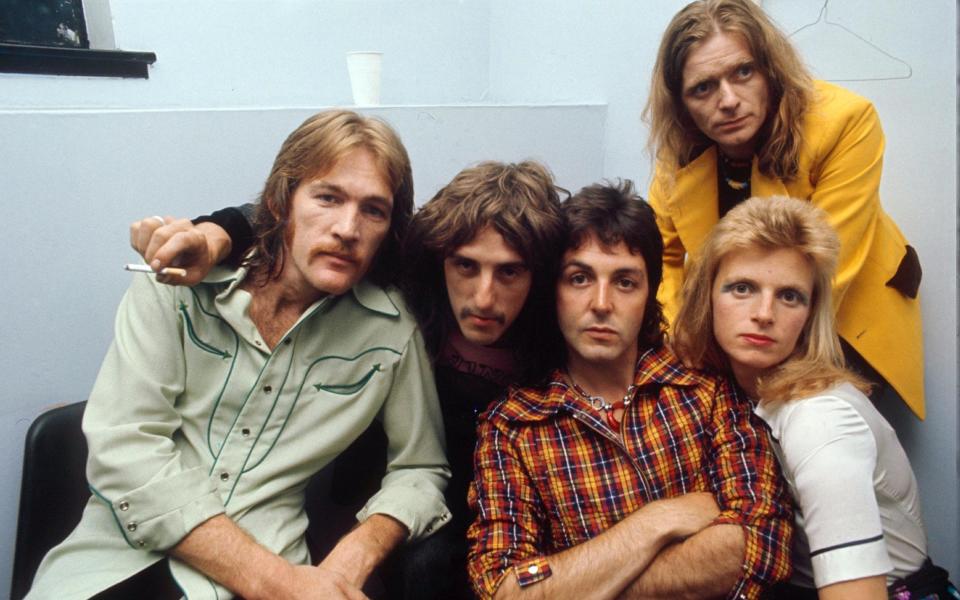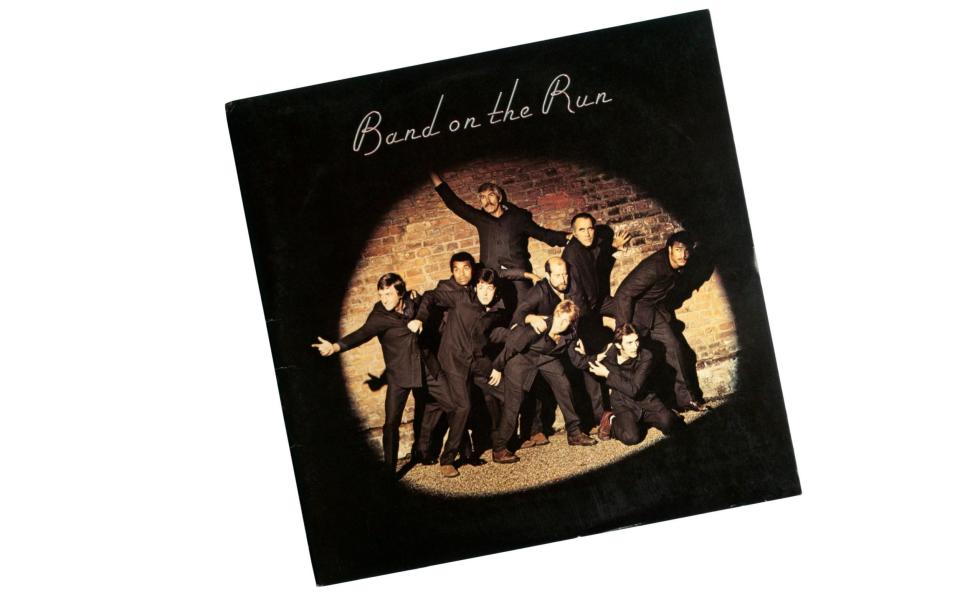Michael Parkinson and James Coburn? The story behind Wings' baffling cover for Band on the Run

Paul McCartney and Wings’ Band on the Run (1973)
With John Lennon among the first wave of British art school rockers, The Beatles were pioneers of sophisticated album covers. From the sly portraits of With the Beatles (1963) and Rubber Soul (1965), via the kaleidoscopic pop art of Revolver (1966) and Sgt Pepper (1967) to the minimalist aestheticism of The Beatles (1968) and casually elegiac snapshot of Abbey Road (1969), they set a gold standard for rock presentation.
Their subsequent solo offerings generally maintained a high visual quality, although Ringo occasionally let the side down (at what meeting for 1981’s Stop and Smell the Roses was it decided that “oleaginous florist” was a good image to project?). Musically, the ex-Beatles were always examined competitively. It is odd to consider with hindsight that Paul McCartney was widely written off as a commercial and artistic disappointment in the early Seventies.
Lennon was the critics’ darling, while George Harrison’s All Things Must Pass (1970) was acclaimed a masterpiece. McCartney’s early solo efforts were (unfairly) dismissed as slapdash, while his new band Wings failed to seize the public imagination. He turned that around with an album evoking the scope and ambition of classic Beatles, wrapped inside a cover whose assembly of characters cheekily hinted at the fate of the Lonely Hearts Club Band, from whom there could be no escape.
What is it?
Band on the Run was McCartney’s fifth album in three years, his third with Wings, and his second of 1973. For all the carping you hear from contemporary artists, musicians just don’t work that hard any more. There was no mention of McCartney on the cover, just the title looming out of blackness, above a motley crew in black uniforms, startled in the glare of a yellow searchlight before an imposing brick wall.

It bore the melodramatic quality of a cinematic jailbreak. On closer inspection, this rag tag band on the run featured familiar faces. Surrounding McCartney, his wife Linda and Wings guitarist Denny Laine, was an odd assortment of celebrities. From left to right: chat show host Michael Parkinson, comedian and singer Kenny Lynch, Hollywood film star James Coburn, former Liberal MP and gourmet Clement Freud, Hammer horror star Christopher Lee and boxer John Conteh. If you are mystified by what could connect such an odd assortment of British TV personalities and movie legends, then you’re probably overthinking it. According to McCartney, they were people whose numbers he had in his phone book, who happened to be around that day.
The story behind the cover
During one of the interminable business meetings during the final days of The Beatles, George Harrison said: “If I ever get out of here …” The phrase stuck in McCartney’s mind, and became the basis for a song about escape and freedom. “He was saying that we were all prisoners in some way,” noted McCartney. “I think most bands on tour are on the run.” McCartney combined different pieces of music in one song, as the Beatles had done on Sgt Pepper and Abbey Road, to create “a transition from captivity to freedom. When the tempo changes at “The rain exploded with a mighty crash”, that feels like a freeing moment.”
It was Linda McCartney who came up with the cover concept. Although her photographs frequently appeared on her husband’s albums, she couldn’t take this since she would be in shot. She suggested Clive Arrowsmith, an art school friend of Lennon’s who was belatedly establishing a career in fashion photography. It was Arrowsmith’s first album shoot, and he almost messed it up by bringing the wrong lights and wrong film. “I really didn’t know what I was doing,” he has admitted. The session took place after dark on October 28, 1973, against the wall of a stable block at Osterley Park, a 16th Century Tudor mansion in West London.
There was little evidence of the painstaking planning Peter Blake had undertaken for Sgt Pepper, as McCartney called famous friends “for a lark”. There was a Liverpool connection to musician turned comic Lynch (who shared bills with the Beatles on early performances) and boxer Conteh (whose fights the McCartney’s attended). Christopher Lee and Clement Freud were social acquaintances from the London dinner-party circuit, Coburn was in the UK filming The Internecine Project, while McCartney lured Parkinson with the promise of appearing on his chat show (an obligation he did not fulfill until 1999).
Dinner with the McCartneys prior to the shoot was a well lubricated affair, and according to Arrowsmith the group turned up in high spirits. “I was the only one who wasn’t wasted,” the photographer recalls. Arrowsmith made the rookie mistake of bringing daytime film instead of the more artificial-light-friendly Tungsten. The single spotlight he had hired proved not bright enough for fast exposure, so the cast was required to hold poses for two seconds at a time. “Everyone was very much the worse for wear but still enjoying each other’s company, to say the least,” according to Arrowsmith. Getting them to stay still “amid the laughter, jokes and substance haze” was a challenge, so he arranged them so they could “lean against each other and the wall, because they had all become a little unsteady on their feet. Denny Laine fell over a couple of times laughing hysterically.”
Arrowsmith positioned himself at the top of a ladder, with a megaphone, barking instructions “which everyone ignored, until I finally snapped and screamed ‘Stay Still!’.” It turned out there were only four frames in focus, and the whole shoot had a sickly yellow pall due to the daylight film. “When it came to showing Paul, I was freaking out too much to say anything. I just held my breath.” McCartney loved them.

What is the music like?
The playful charm and drama of the cover is reflected on an album that McCartney has referred to as “an epic adventure”. Quirky, shapeshifting song structures are expanded with inventive arrangements of harmonic depth, McCartney’s eccentric narratives and glorious melodies underscored by an emotional mood of nostalgic love and longing. Many fans still consider it to be McCartney’s best, and it is certainly his most Beatley, closing with a Sgt Pepper like reprise of the title track. It was recorded under some stress, at an underequipped eight-track studio in Lagos, Nigeria, after two original members of Wings suddenly quit.
Making a virtue of necessity, McCartney played almost everything himself (drums, bass, keyboards and lead guitar), with Laine on rhythm guitar and Linda on backing vocals. McCartney produced, Beatles collaborator Geoff Emerick engineered, with Tony Visconti adding string arrangements in London. Bluebird and Mamunia display McCartney at his dreamiest, Jet and Mrs Vanderbilt are fantastic soft rockers, Picasso’s Last Words (Drink to Me) offers a melancholy campfire singalong that reprises earlier songs. The slow-burning Let Me Roll It is so Lennonesque that his old bandmate thought McCartney had written it as a message of love and forgiveness.
What is its legacy?
On its release in 1973, Band on the Run barely scraped into the top 10 in the UK or US. But over the course of 1974, its reputation grew. It went on to sell over 8 million copies, establishing Wings as a supergroup, albeit not with the starry membership featured on the cover. Arrowsmith continued to work with McCartney, shooting the back cover of Wings at the Speed of Sound in 1976. It was only then that he told McCartney how he nearly messed up Band on the Run. McCartney laughed it off, admitting he just presumed the yellow lighting effect was conceptual.
How does Band on the Run compare to The Beatles? And did Paul McCartney ever match it again? Neil McCormick will be in the comments section of this article between 4pm and 5pm today

